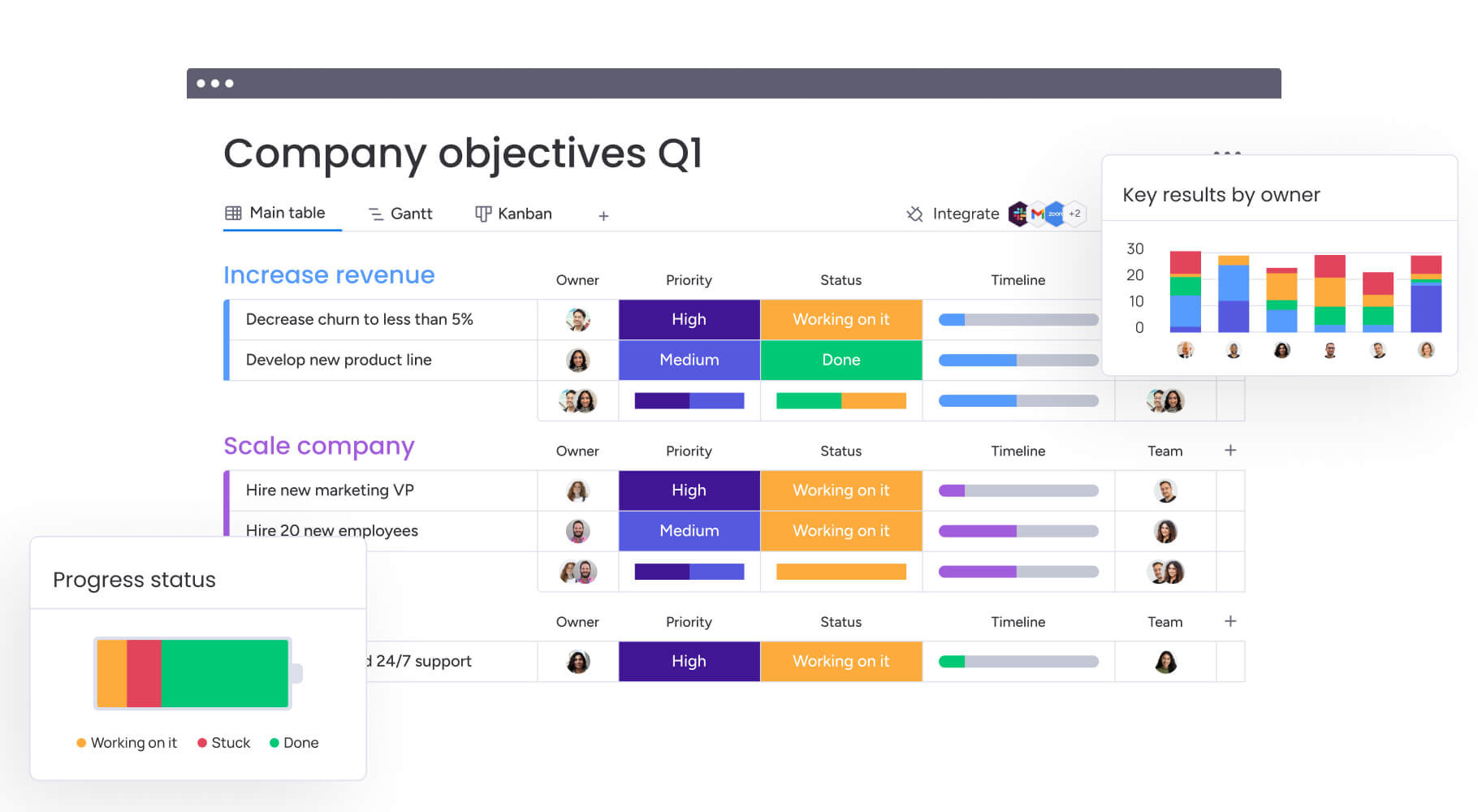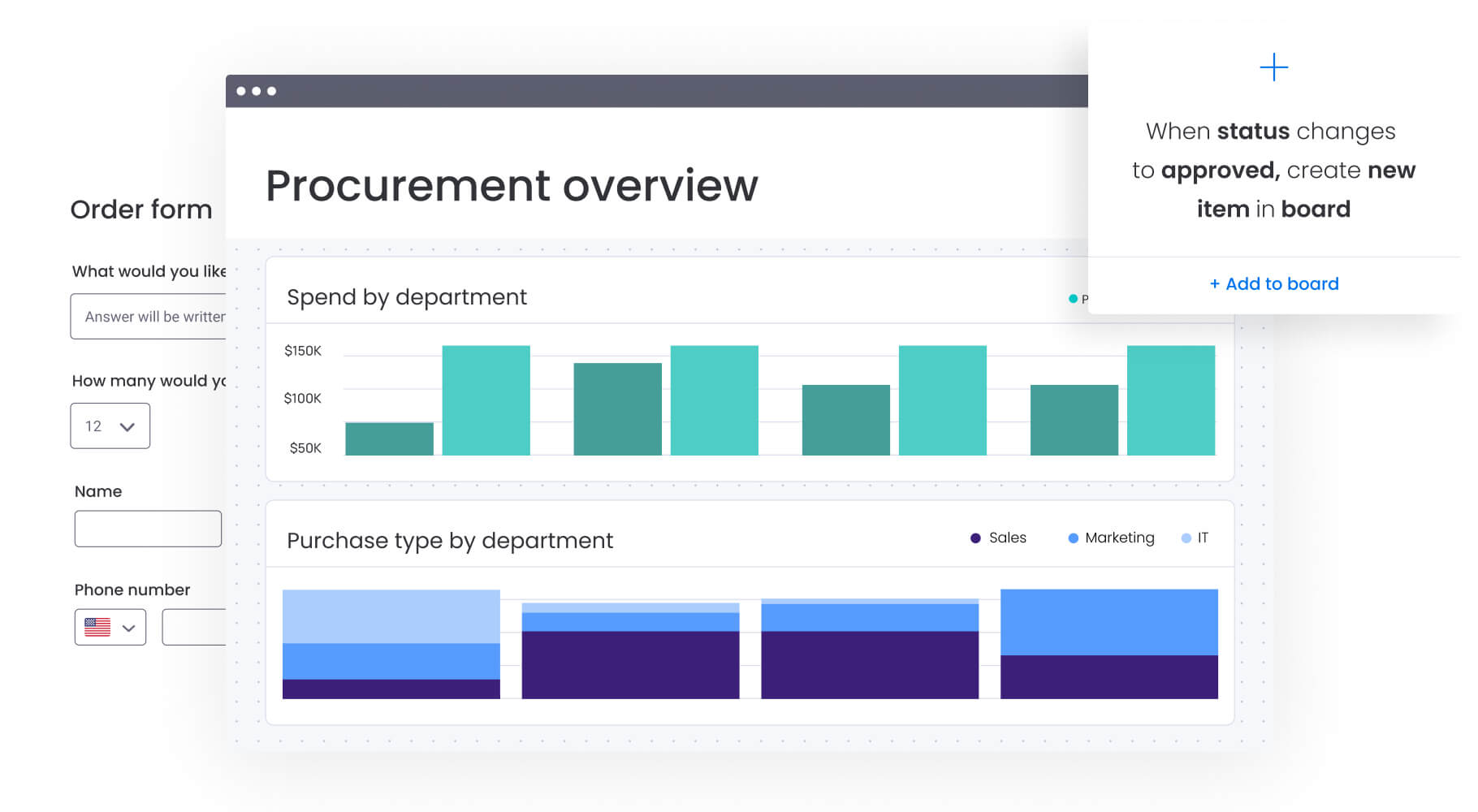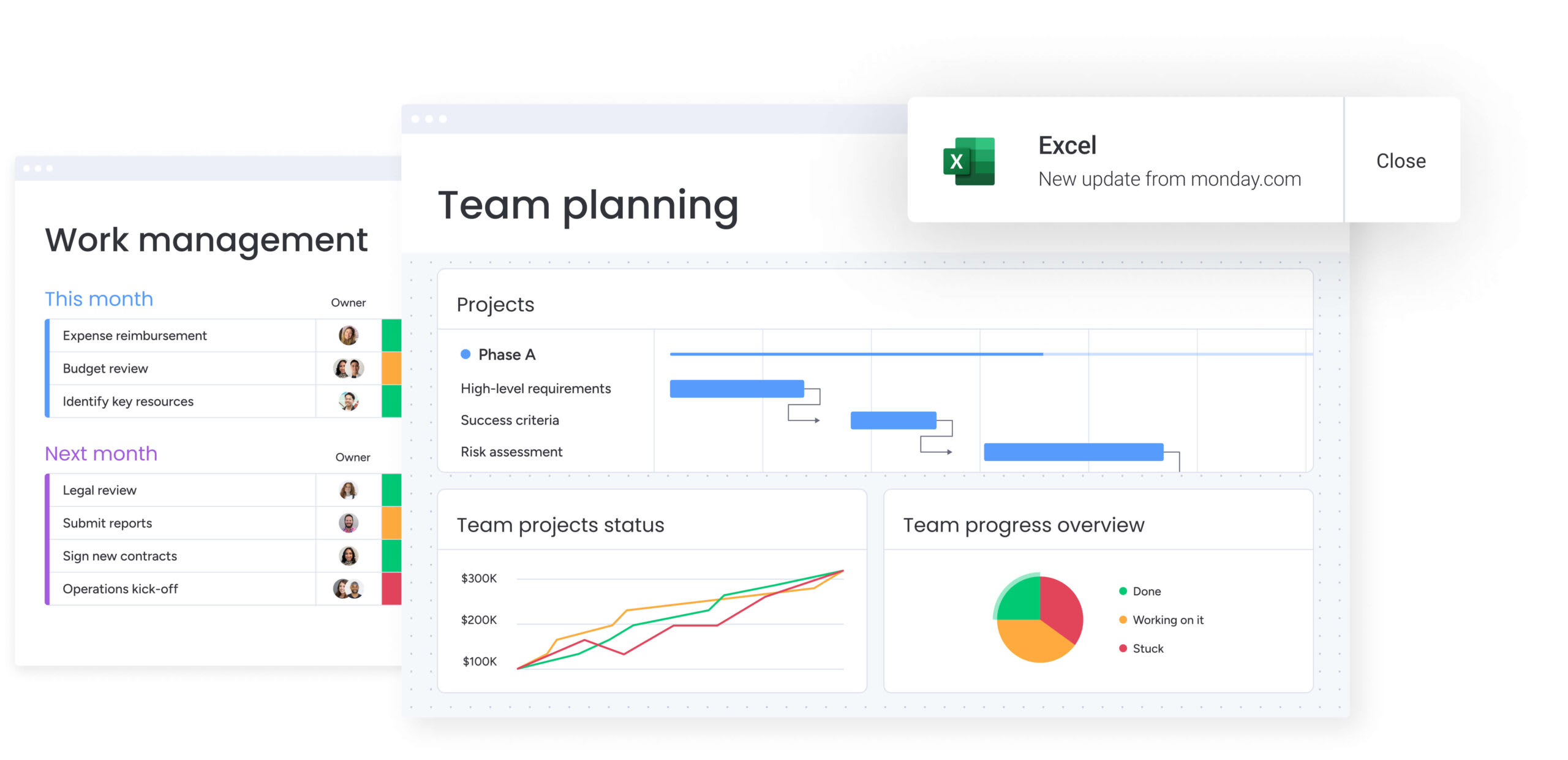Why do some businesses scale effortlessly while others struggle with bottlenecks, inefficiencies, and misalignment? The difference comes down to a strong operations strategy.
An effective operations strategy accounts for internal workflows and external factors. It considers market trends, economic shifts, customer expectations, and industry regulations. It provides the structure to turn high-level business goals into real-world execution while keeping teams focused, workflows efficient, and resources optimized.
Without it, companies risk wasted effort, rising costs, and missed opportunities. A strong strategy creates clarity and alignment, ensuring every process supports long-term growth — even in a changing business landscape.
Let’s explore what it is, why it matters, and how to build one that actually works.
What is an operations strategy?
An operations strategy is a structured plan for organizing a company’s resources, workflows, and processes to support long-term business goals. It dictates how work is completed at scale across key areas such as:
- Product management
- Supply chain management
- Resource allocation
- Workflow automation
- Scheduling
- Forecasting
- Facilities planning and management
- Performance tracking
- Financing
- Marketing
- Human resources
By implementing a well-structured operations strategy, businesses can streamline processes, improve collaboration, and make informed decisions that support growth. But strategy alone doesn’t drive results — execution does. A clear operational structure ensures that goals turn into measurable actions, resources are optimized, and teams stay aligned.
Why structure matters for a successful operations strategy
A well-defined structure keeps operations efficient, predictable, and scalable. Without it, even the most well-planned strategies can lead to inefficiencies, misalignment, and stalled progress.
- Workflow standardization: Repeatable, scalable processes eliminate inconsistencies and reduce inefficiencies, helping teams focus on execution rather than troubleshooting.
- Smarter resource allocation: Proactive operational planning prevents teams from being overburdened or underutilized, ensuring personnel and budgets are distributed effectively.
- Measurable execution: Data-driven insights from live tracking and reporting tools allow teams to adjust strategies and optimize decision-making in real time.
- Stronger cross-functional collaboration: A well-structured strategy breaks down silos, fosters communication, and ensures every department shares a common understanding of goals and responsibilities.
- Cost efficiency and risk reduction: Identifying wasteful processes and implementing proactive risk management strategies minimize disruptions and help businesses scale sustainably.
- Scalability for growth: As organizations expand, structured business operations ensure that processes and technology scale efficiently without sacrificing agility or execution speed.
With automation, goal-setting tools, and dynamic reporting, enterprises can build a structured operations strategy that adapts to change while maintaining efficiency.
Ready to transform your operations? Get started with our operational plan template.
11 areas to focus on when developing an operations strategy
An operations strategy determines how key functions within a business work together to support long-term goals. To build an effective strategy, organizations must assess the core areas that impact execution, efficiency, and scalability. These areas serve as the foundation for operational planning and should be aligned with business objectives to maximize impact.
Key areas to evaluate when developing an operations strategy:
- Product management: A well-defined product management strategy ensures that development, production, and delivery align with market needs and business goals. Businesses must optimize product lifecycles, maintain quality control, and streamline innovation to stay competitive.
- Supply chain management: A strong supply chain strategy keeps suppliers, manufacturers, and distribution channels in sync — reducing delays, minimizing waste, and controlling costs. Companies that refine logistics, strengthen supplier relationships, and optimize inventory gain a competitive advantage.
- Resource allocation: Efficient use of people, time, and capital is critical for operational success. Strategic resource allocation ensures that workloads are balanced, teams are adequately staffed, and budgets are distributed effectively.
- Workflow automation: Automating repetitive tasks improves efficiency and reduces human error. Standardized process management allows teams to work more productively by eliminating redundancies and keeping operations running smoothly. For example, HR teams can automate workflows for employee onboarding to ensure new hires follow a structured process with minimal manual oversight.
- Scheduling: Effective scheduling ensures that projects, workforce management, and production timelines align with demand. Businesses must coordinate workflows to avoid bottlenecks and maintain productivity.
- Forecasting: Data-driven forecasting helps businesses anticipate demand, allocate resources efficiently, and prepare for market shifts. Leveraging predictive analytics and real-time insights allows organizations to adjust their strategies proactively.
- Facilities planning and management: As businesses grow, so do their space and infrastructure needs. Scalable facility planning ensures that operational environments, from office space to manufacturing sites, support long-term objectives.
- Performance tracking: Key performance indicators (KPIs) and analytics provide real-time visibility into operational efficiency. Organizations must track metrics across departments to identify areas for improvement and optimize execution.
- Financing: Operational budgets must align with business priorities to support growth and stability. Organizations need structured financial planning to manage cash flow, control costs, and allocate funds effectively.
- Marketing: An operations strategy supports marketing by ensuring that campaigns, content production, and promotional activities align with broader business goals. Well-coordinated marketing operations improve efficiency and maximize return on investment.
- Human resources: HR plays a crucial role in workforce planning, talent management, and employee engagement. A strong HR strategy ensures that teams are equipped with the right skills and resources to drive operational success.
5 types of operations strategies
Every business operates differently, but one thing remains constant: how effectively a company executes its operations determines its success. A strong operations strategy defines how a business delivers value, aligning processes with its goals, industry standards, and market dynamics.
Some companies focus on refining core strengths, while others prioritize competitive positioning, innovation, or customer experience. The right approach depends on business objectives and external factors like economic trends, customer demand, and emerging technologies.
Here are 5 key types of operations strategies, along with real-world examples of companies that excel in each:
- Core competency strategies: This approach focuses on leveraging a company’s strengths to maximize profitability. For example, Apple’s ability to create seamless hardware and software integration has been its competitive advantage for decades. By refining and reinforcing this core competency, Apple ensures continued customer loyalty and premium pricing power.
- Corporate strategies: This strategy centers around a company’s mission and long-term vision. This involves defining key performance indicators (KPIs), decision-making processes, and structuring production initiatives. For example, Tesla’s corporate strategy revolves around accelerating the transition to sustainable energy. This guides everything from its manufacturing processes to battery research and charging infrastructure expansion.
- Competitive strategies: A competitive strategy differentiates a business from others in the industry. A company might introduce a unique pricing model, proprietary technology, or customer perks to gain a competitive edge — similar to how Amazon Prime created a loyalty-driven subscription model to retain customers.
- Product or service strategies: This approach prioritizes product development, quality control, and innovation. Product managers are key in refining offerings and ensuring they meet customer needs while maintaining efficiency. Dyson, for example, has built its reputation on engineering high-performance vacuum cleaners, hair dryers, and air purifiers. By investing in R&D and refining product design, Dyson maintains a premium brand image while staying ahead of industry trends.
- Customer-driven strategies: This strategy revolves around the customer experience. It requires businesses to base operational decisions on customer insights, feedback, and engagement — often led by sales and marketing teams. Starbucks, for example, consistently adapts its menu and service model based on customer preferences, from offering plant-based alternatives to integrating mobile ordering for convenience. By prioritizing the customer experience, companies build stronger brand loyalty and long-term success.
Building an operations strategy step by step
A successful operations strategy isn’t developed in isolation. Businesses must consider both internal capabilities and external factors — market trends, customer expectations, and competitor strategies — to create a sustainable and scalable approach.
Here’s a structured, data-driven guide to building an effective operations strategy:
1. Define business goals and objectives
Start by outlining clear, measurable business goals and the objectives that support them. Goals define the broader vision (e.g., improving efficiency, reducing costs, or enhancing customer experience), while objectives are specific, actionable steps that move the business toward these goals.
2. Analyze current operations and resources
Assess your internal workflows, technology, and team capacity. Identify inefficiencies, redundancies, or gaps that may be limiting productivity. Where are the bottlenecks? Which processes need automation? This analysis helps determine where operational improvements are needed.
3. Conduct market research and assess demand
An operations strategy must align with external realities. Analyze industry trends, customer behavior, and competitor strategies to ensure your business remains relevant. What do customers expect? What gaps exist in the market? Understanding these factors allows businesses to adjust operations to meet changing demands.
4. Perform a SWOT analysis
A SWOT (Strengths, Weaknesses, Opportunities, Threats) analysis provides a structured way to evaluate your company’s internal strengths and weaknesses while identifying external opportunities and threats. This step helps businesses leverage their advantages while mitigating risks.
Get the template: Download your free SWOT analysis template now.
5. Design a structured plan and workflows
With insights from the previous steps, develop a detailed action plan. This includes defining key processes, implementing standardized workflows, and identifying the tools and methodologies that will support execution. Clear documentation ensures repeatable, scalable operations.
6. Allocate resources and assign responsibilities
Effective resource planning ensures that teams, budgets, and technology are used efficiently. Assign clear roles and responsibilities, balance workloads, and integrate enterprise resource planning software.
7. Implement automation
Manual processes slow down execution and increase the risk of errors. By leveraging automation and workflow management tools, businesses can streamline operations, reduce administrative burdens, and free up employees for high-impact tasks.
8. Monitor & optimize
An operations strategy must evolve based on real-time insights. Use interactive dashboards and performance tracking tools to measure key metrics, identify areas for improvement, and adjust workflows as needed. Continuous optimization ensures long-term success.
Key metrics to measure the success of your operations strategy
Tracking the right key performance indicators (KPIs) helps businesses assess efficiency, identify bottlenecks, and optimize workflows for long-term success. But measuring KPIs isn’t enough on its own. The real value comes from acting on the insights they provide.
By regularly reviewing performance data, teams can:
- Identify inefficiencies before they escalate into larger issues
- Refine workflows by investing in automation and process improvements
- Make data-driven decisions that enhance scalability and business impact
To ensure your operations strategy delivers measurable results, focus on these essential metrics:
Operational efficiency
Efficiency determines how smoothly workflows are executed. The goal is to reduce execution time and minimize manual effort.
How to measure: Track process completion time, automation adoption rates, and reductions in manual workload.
Cycle time
Cycle time measures how long it takes to complete a process from start to finish. Faster cycles improve agility in areas like product development and customer onboarding.
How to measure: Monitor the average time required to complete key workflows and identify bottlenecks that cause delays.
Cost per operation
Operational costs should align with output and efficiency. Overspending on routine tasks signals inefficiencies that need attention.
How to measure: Compare budgeted vs. actual operational costs, analyze cost-per-task, and identify wasted resources.
Resource utilization
Teams perform best when workloads are balanced. Underutilized employees represent missed opportunities, while overburdened teams risk burnout and decreased productivity.
How to measure: Assess workload distribution, team capacity, and project load balancing metrics.
Customer satisfaction and retention
Operations strategy doesn’t just impact internal teams — it directly affects customer experience.
How to measure: Track Net Promoter Score (NPS), customer churn rate, and feedback trends to gauge satisfaction.
A strong operations strategy is never “set and forget.” The continuous process of optimizing, scaling, and improving will let you know where to focus next with the right KPIs in place.
Common pitfalls in operations strategy (and how to avoid them)
Even the strongest operations strategies can run into roadblocks. Recognizing and addressing challenges early prevents delays, inefficiencies, and misalignment. Here’s what to watch for:
- Unclear or shifting goals: When goals aren’t clearly defined, teams waste time on tasks that don’t contribute to business growth. Setting measurable, time-bound OKRs (objectives and key results) keeps teams focused and aligned.
- Bottlenecks that slow execution: A slow approval process, redundant workflows, or outdated systems create inefficiencies that stall progress. Regularly auditing workflows and automating repetitive tasks reduces friction and speeds up execution.
- Teams working in silos: Lack of collaboration leads to duplicated work, misaligned priorities, and stalled projects. Shared dashboards, standardized communication channels, and clear ownership improve alignment and cross-team coordination.
- Ignoring data until problems escalate: Without up-to-date insights, teams can’t track performance trends or make informed decisions. Live dashboards and performance tracking tools help teams identify inefficiencies early and adjust strategies as needed.
- Processes that don’t scale: Workflows designed for a small team often become unmanageable as the business grows. Automating repetitive tasks, designing adaptable workflows, and implementing scalable processes maintain efficiency as demands increase.
A strong operations strategy isn’t static. Proactively identifying and resolving these challenges ensures workflows remain efficient, teams stay aligned, and processes scale with the business.
Turn strategy into action with monday work management
Tracking success is one thing — executing efficiently is another. Without the right tools, like business process management software, even the best operations strategy can fall apart. That’s where monday work management comes in.
Businesses can bridge this gap and turn strategic goals into measurable results by using a centralized platform like monday work management. Here’s how:
Align strategy with execution

Teams can lose focus on strategic priorities without a structured way to connect company objectives to day-to-day work. With Goals & OKRs in monday work management, enterprises can set clear objectives, assign responsibilities, and track progress as it happens, ensuring that every project, initiative, and task contributes to the bigger picture.
Gain real-time visibility into execution

To stay agile, enterprises need instant access to progress updates, resource allocation, and potential risks. Dashboards and reporting tools in monday work management provide a 360-degree view of all projects, timelines, and KPIs, enabling teams to make informed decisions, address roadblocks early, and maintain control at scale.
Optimize resource planning

Mismanaged resources lead to inefficiencies, budget overruns, and overwhelmed teams. To prevent bottlenecks, the Resource Planner in monday work management helps organizations balance workloads, allocate personnel effectively, and ensure the right people are assigned to the right projects at the right time.
Break down silos and improve collaboration

Disconnected teams create delays and inconsistencies, making it challenging to align operations across departments. A centralized workspace, like monday work management, allows teams to collaborate instantly, share updates, and stay aligned — eliminating inefficiencies caused by fragmented communication.
Automate workflows for seamless execution

Manual processes slow execution and increase the risk of errors. By automating repetitive tasks, standardizing approvals, and streamlining workflows, monday work management helps teams work faster while maintaining consistency.
With these capabilities, enterprises can execute their operations strategy with precision, ensuring every initiative drives meaningful impact.
A smarter way to manage your operations strategy
A strong operations strategy is essential for business success, but execution is where many organizations struggle. Without structured workflows, performance tracking, and scalable systems, inefficiencies creep in, slowing growth.
With monday work management, businesses can execute with precision. From goal-setting and automation to resource planning and risk management, the platform brings clarity, flexibility, and control to operations strategy.
Ready to enhance your operations strategy? Get started with monday work management today.
FAQs
What is operations strategy in operations management?
Operations strategy aligns a company’s workflows, resources, and processes with its long-term goals to drive efficiency, scalability, and team alignment.
What are the 4 competitive priorities in an operations strategy?
The 4 competitive priorities are cost, quality, flexibility, and speed. They help businesses shape their operations to maximize efficiency and maintain a competitive edge.
- Cost: Reducing expenses while maintaining productivity and profitability. Companies prioritize cost efficiency by streamlining workflows, optimizing supply chains, and leveraging automation to minimize waste.
- Quality: Ensuring products or services meet high standards and customer expectations. Businesses focus on quality control, continuous improvement, and process consistency to maintain reliability and trust.
- Flexibility: The ability to adapt to changing demands, whether by offering customized solutions, adjusting production volumes, or responding to market shifts. Agile businesses can pivot quickly without disrupting operations.
- Speed: Delivering products or services quickly and efficiently. This includes reducing cycle times, improving logistics, and eliminating bottlenecks to accelerate output while maintaining quality.
What does a strategy and operations manager do?
A strategy and operations manager oversees resource planning, workflow optimization, and process improvements to enhance efficiency and business growth.
What are the 5 Ps of operations strategy?
The 5 Ps are people, processes, products, partners, and performance.
- People: A strong strategy focuses on hiring, training, and retaining skilled employees while fostering a culture of collaboration and innovation.
- Processes: Continuous process optimization leads to better operational outcomes.
- Products: The goods or services a company offers must align with market demand, quality standards, and customer expectations.
- Partners: A well-structured supply chain and reliable partnerships enhance efficiency and reduce risks.
- Performance: Measuring key performance indicators (KPIs) and tracking efficiency, quality, and customer satisfaction help businesses refine their operations and drive continuous improvement.
What are the 4 perspectives of operations strategy?
The 4 perspectives of operations strategy are top-down, bottom-up, market-led, and resource-based. Each shapes how businesses approach decision-making and execution
- Top-down: Strategy is driven by high-level business goals and cascades down to operational decisions. Leadership sets priorities, and teams align their workflows to achieve these objectives.
- Bottom-up: Insights and improvements emerge from day-to-day operations. Employees identify challenges and opportunities, influencing strategy through continuous process enhancements.
- Market-Led: Customer needs, competitor actions, and market trends shape operations. Businesses adjust their processes and capabilities to stay competitive and meet demand.
- Resource-Based: Strategy focuses on leveraging a company’s existing strengths, such as proprietary technology, talent, or supply chain advantages, to build a sustainable competitive edge.
What is an example of an operations strategy?
One example of an operations strategy would be a retail company optimizing its supply chain by implementing automation, improving inventory management, and enhancing distribution processes.
 Get started
Get started 
